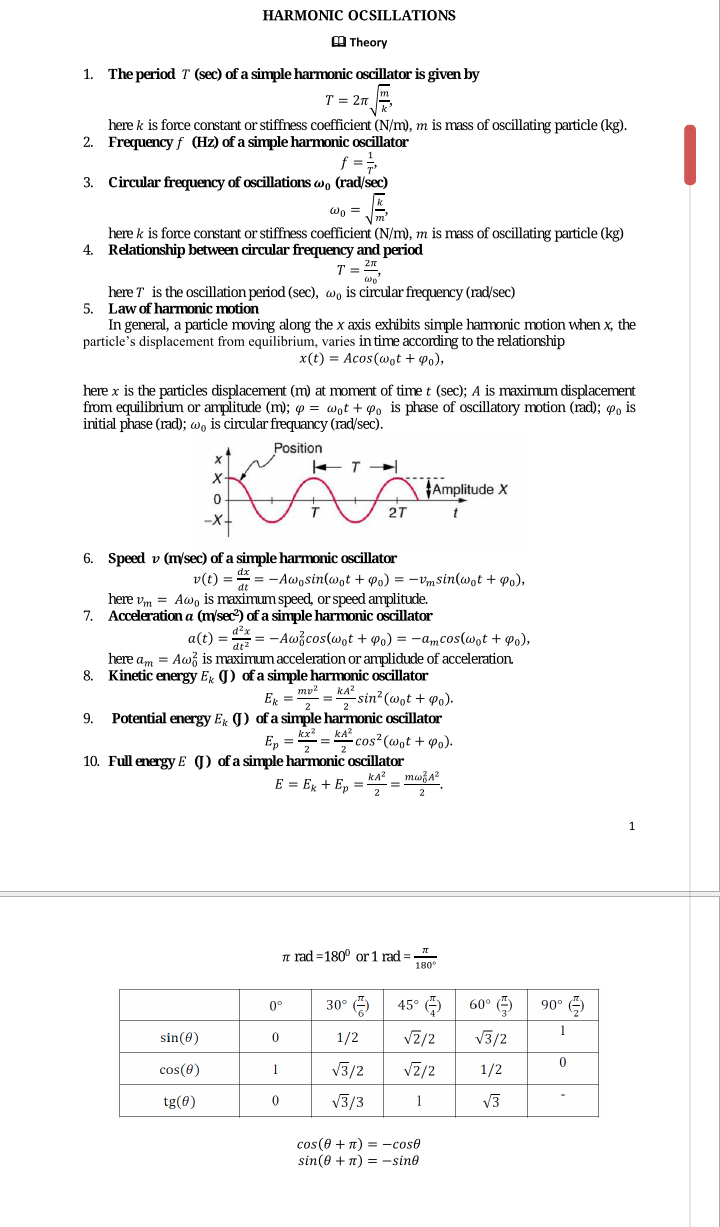2. An object oscillates with simple harmonic motion along the x axis. Its displacement from the origin varies with time according to the equationx = 4cos (nt +) where tis in seconds and the angles in the parentheses are in radians. (a) Detemine the position x, velocity v, and acceleration a of the object at t = 1 sec. (b) Determine the maximum speed vm and maximum acceleration a,m of the object. HARMONIC OCSILLATIONS A Theory The period T (sec) of a simple harmonic oscillator is given by 1. T = 2n here k is force constant or stiffness coefficient (N/m), m is mass of oscillating particle (kg). Frequencyf (Hz) of a simple harmonic oscillator 2. f = = Circular frequency of oscillations w, (rad/sec) 3. here k is force constant or stiffness coefficient (N/m), m is mass of oscillating particle (kg) 4. Relationship between circular frequency and period here T is the oscillation period (sec), wo is circular frequency (rad/sec) 5. Law of harmonic motion In general, a particle moving along the x axis exhibits simple hamonic motion when x, the particle's displacement from equilibrium, varies intime according to the relationship x(t) = Acos(@ot + Po), here x is the particles displacement (m) at moment of time t (sec); A is maximum displacement from equilibrium or amplitude (m); 4 = wot + wo is phase of oscillatory motion (rad); 4, is initial phase (rad); wo is circular frequancy (rad/sec). Position Amplitude X 6. Speed v (m/sec) of a simple harmonic oscillator = -Awosin(@ot + Po) = -Vmsin(wot + Po), v(t) = dt here vm = Aw, is maximum speed, or speed amplitude. 7. Accelerationa (m/sec) of a simple harmonic oscillator = -Awžcos(wot + Po) = -amcos(wot + Po), a(t) = dt? here am = Aw is maximum acceleration or amplidude of acceleration Kinetic energy Ex J) of a simple harmonic oscillator E, = m = KA sin? (wnt + @o). 8. kA2 mv2 Potential energy E, () of a simple harmonic oscillator 9. kx? cos? (wot + Po). Ep = = J) of a simple harmonic oscillator Full energy E 10. kA? тодА? %3D E = Ex + E, = 2 A rad =180° or 1 rad = 180° 30° () 45° G 90° E 60° 0° VZ/2 V3/2 sin(0) 1/2 V3/2 VZ/2 1/2 cos(0) V3/3 V3 1 tg(0) cos (0 + n) = -cose sin(0 + n) = -sine
Simple harmonic motion
Simple harmonic motion is a type of periodic motion in which an object undergoes oscillatory motion. The restoring force exerted by the object exhibiting SHM is proportional to the displacement from the equilibrium position. The force is directed towards the mean position. We see many examples of SHM around us, common ones are the motion of a pendulum, spring and vibration of strings in musical instruments, and so on.
Simple Pendulum
A simple pendulum comprises a heavy mass (called bob) attached to one end of the weightless and flexible string.
Oscillation
In Physics, oscillation means a repetitive motion that happens in a variation with respect to time. There is usually a central value, where the object would be at rest. Additionally, there are two or more positions between which the repetitive motion takes place. In mathematics, oscillations can also be described as vibrations. The most common examples of oscillation that is seen in daily lives include the alternating current (AC) or the motion of a moving pendulum.
An object oscillates with


Trending now
This is a popular solution!
Step by step
Solved in 7 steps with 7 images









